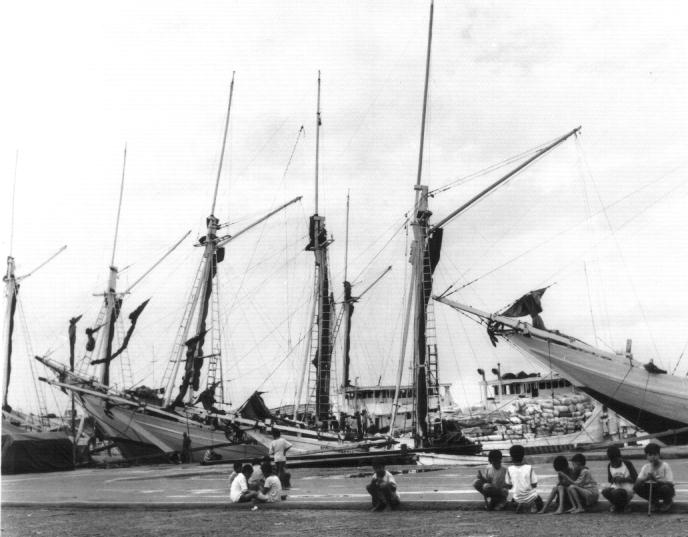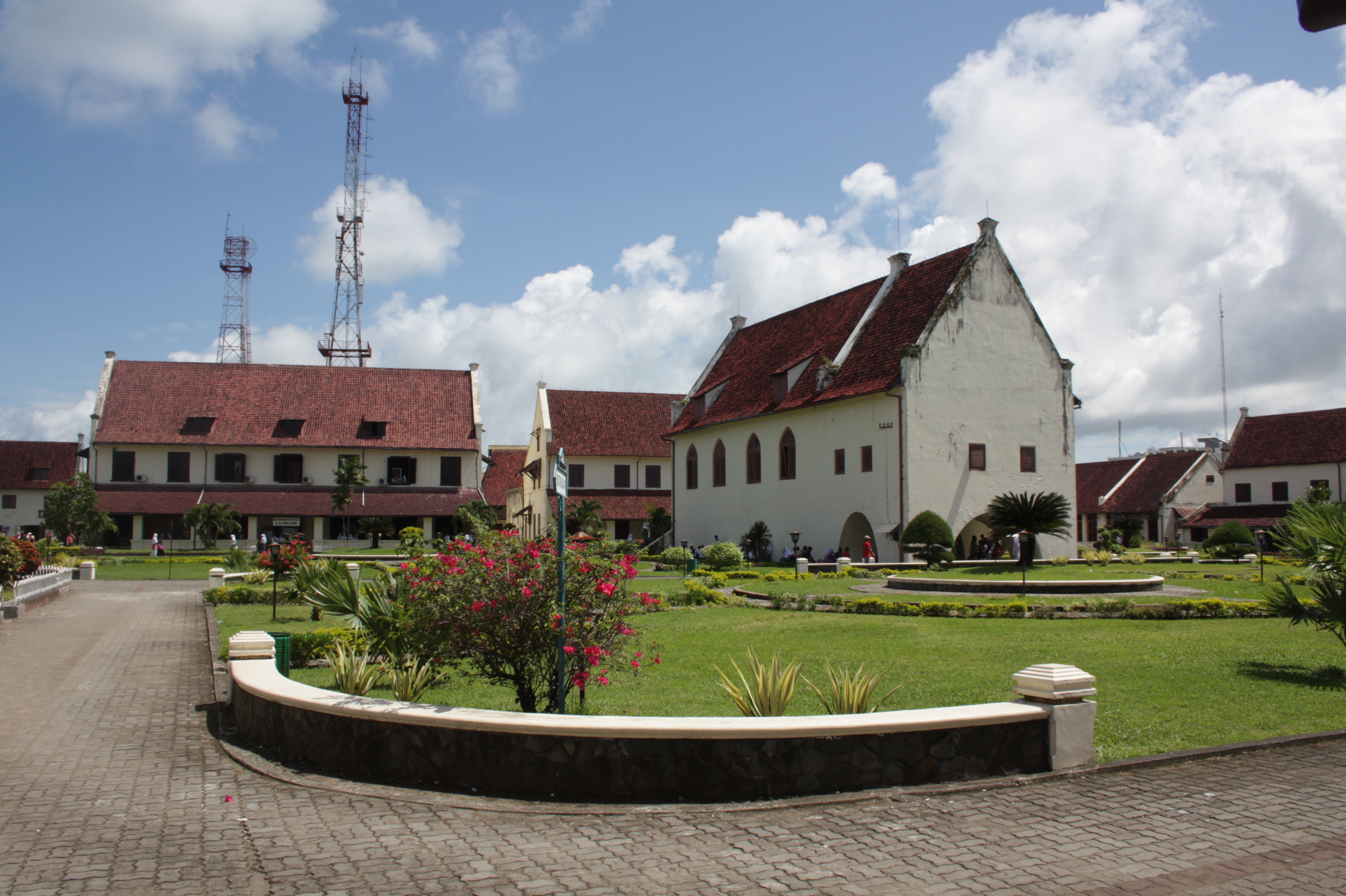|
Pinisi
Literally, the word pinisi refers to a type of rigging (the configuration of masts, sails and ropes (‘lines’)) of Indonesian Sailing ship, sailing vessels. A pinisi carries seven to eight sails on two masts, arranged like a gaff-ketch with what is called 'standing gaffs' — i.e., unlike most Western ships using such a rig, the two main sails are not opened by raising the spars they are attached to, but the sails are 'pulled out' like curtains along the gaffs which are fixed at around the centre of the masts. As is the case with many Indonesia sailing craft, the word 'pinisi' thus names only a type of rig, and does not describe the shape of the hull of a vessel that uses such sails. Pinisi-rigged ships were mainly built by the Konjo-speaking people of Ara, a village in the district of Bontobahari, Bulukumba regency, South Sulawesi, and widely used by Bugis, Buginese and Makassarese seafarers as a cargo vessel. In the years before the eventual disappearance of wind-powered tr ... [...More Info...] [...Related Items...] OR: [Wikipedia] [Google] [Baidu] |
Palari (boat)
Palari is a type of Indonesian sailing vessel from South Sulawesi. It was mainly used by the people of Ara and Lemo Lemo, for transporting goods and people. This vessel is rigged with pinisi rig, which often makes it better known as "Pinisi" instead of its name. In Singapore, palari is known as "Makassar trader". Etymology The name of this boat comes from Bugis word ''lari'' meaning "to run" or "running". The word ''pa'' is a suffix used in forming nouns designating persons from the object of their occupation or labor, equivalent to English -or/-er, so the meaning of ''palari'' would be "runner". This refers to the fact that this vessel is nimbler and faster than its predecessor, the padewakang.Vuuren, L. Van 1917. 'De Prauwvaart van Celebes'. ''Koloniale Studien'', 1,107-116; 2, 329-339, pg. 108. Description Palari is about 50–70 feet (15.24–21.34 m) in length overall, with light laden waterline of 34–43 feet (10.36–13.1 m). The sails are built using light canvas, w ... [...More Info...] [...Related Items...] OR: [Wikipedia] [Google] [Baidu] |
Bugis
The Bugis people (pronounced ), also known as Buginese, are an ethnicity—the most numerous of the three major linguistic and ethnic groups of South Sulawesi (the others being Makassar and Toraja), in the south-western province of Sulawesi, third-largest island of Indonesia. The Bugis in 1605 converted to Islam from Animism. The main religion embraced by the Bugis is Islam, with a small minority adhering to Christianity or a pre-Islamic indigenous belief called ''Tolotang''. Despite the population numbering only around six million, the Bugis are influential in the politics in modern Indonesia, and historically influential on the Malay peninsula, Sumatra, Borneo, Lesser Sunda Islands and other parts of the archipelago where they have migrated, starting in the late seventeenth century. The third president of Indonesia, B. J. Habibie, and a former vice president of Indonesia, Jusuf Kalla, are Bugis. In Malaysia, the former prime minister Muhyiddin Yassin has Bugis ances ... [...More Info...] [...Related Items...] OR: [Wikipedia] [Google] [Baidu] |
South Sulawesi
South Sulawesi ( id, Sulawesi Selatan) is a province in the southern peninsula of Sulawesi. The Selayar Islands archipelago to the south of Sulawesi is also part of the province. The capital is Makassar. The province is bordered by Central Sulawesi and West Sulawesi to the north, the Gulf of Bone and Southeast Sulawesi to the east, Makassar Strait to the west, and Flores Sea to the south. The 2010 census estimated the population as 8,032,551 which makes South Sulawesi the most populous province on the island (46% of the population of Sulawesi is in South Sulawesi), and the sixth most populous province in Indonesia. At the 2020 Census this had risen to 9,073,509,Badan Pusat Statistik, Jakarta, 2021. and the official estimate as at mid 2021 was 9,139,531. The main ethnic groups in South Sulawesi are the Buginese, Makassarese, Toraja, and Mandar. The economy of the province is based on agriculture, fishing, and mining of gold, magnesium, iron and other metals. The pinisi, a trad ... [...More Info...] [...Related Items...] OR: [Wikipedia] [Google] [Baidu] |
UNESCO Intangible Cultural Heritage Lists
UNESCO established its Lists of Intangible Cultural Heritage with the aim of ensuring better protection of important intangible cultural heritages worldwide and the awareness of their significance.Compare: This list is published by the Intergovernmental Committee for the Safeguarding of Intangible Cultural Heritage, the members of which are elected by State Parties meeting in a General Assembly. Through a compendium of the different oral and intangible treasures of humankind worldwide, the programme aims to draw attention to the importance of safeguarding intangible heritage, which UNESCO has identified as an essential component and as a repository of cultural diversity and of creative expression. The list was established in 2008 when the 2003 Convention for the Safeguarding of the Intangible Cultural Heritage took effect. the programme compiles two lists. The longer, Representative List of the Intangible Cultural Heritage of Humanity, comprises cultural "practices and expressio ... [...More Info...] [...Related Items...] OR: [Wikipedia] [Google] [Baidu] |
Indonesia
Indonesia, officially the Republic of Indonesia, is a country in Southeast Asia and Oceania between the Indian and Pacific oceans. It consists of over 17,000 islands, including Sumatra, Java, Sulawesi, and parts of Borneo and New Guinea. Indonesia is the world's largest archipelagic state and the 14th-largest country by area, at . With over 275 million people, Indonesia is the world's fourth-most populous country and the most populous Muslim-majority country. Java, the world's most populous island, is home to more than half of the country's population. Indonesia is a presidential republic with an elected legislature. It has 38 provinces, of which nine have special status. The country's capital, Jakarta, is the world's second-most populous urban area. Indonesia shares land borders with Papua New Guinea, East Timor, and the eastern part of Malaysia, as well as maritime borders with Singapore, Vietnam, Thailand, the Philippines, Australia, Palau, and India ... [...More Info...] [...Related Items...] OR: [Wikipedia] [Google] [Baidu] |
Makassar
Makassar (, mak, ᨆᨀᨔᨑ, Mangkasara’, ) is the capital of the Indonesian province of South Sulawesi. It is the largest city in the region of Eastern Indonesia and the country's fifth-largest urban center after Jakarta, Surabaya, Medan, and Bandung.Ministry of Internal AffairsRegistration Book for Area Code and Data of 2013/ref> The city is located on the southwest coast of the island of Sulawesi, facing the Makassar Strait. Throughout its history, Makassar has been an important trading port, hosting the center of the Gowa Sultanate and a Portuguese naval base before its conquest by the Dutch East India Company in the 17th century. It remained an important port in the Dutch East Indies, serving Eastern Indonesian regions with Makassarese fishers going as far south as the Australian coast. For a brief period after Indonesian independence, Makassar became the capital of the State of East Indonesia, during which an uprising occurred. The city's area is , and it had ... [...More Info...] [...Related Items...] OR: [Wikipedia] [Google] [Baidu] |
Pinas (ship)
The ''pinas'', sometimes called "pinis" as well, is a type of schooner of the east coast of the Malay peninsula, built in the Terengganu area. This kind of vessel was built of Chengal wood by the Malays since the 19th century and roamed the South China Sea and adjacent oceans as one of the two types of traditional sailing vessels the late Malay maritime culture has developed: The ''bedar'' and the ''pinas''. Description The pinas is a sailing vessel built exclusively in the kuala (Malay: rivermouth) of the Terengganu river. It was the largest of the ships built in the area, and was only used for deep sea navigation to distant ports. The pinas carried two masts, one in the bow, called "Topan", slightly raked forward, and the main mast, called "Agung" placed a bit forward of the center of the boat. The pinas had a very long bowsprit, slightly bent downwards by the bobstay. The original pinas was schooner-rigged with Bermuda topsails. This type was recorded by Herbert Warington ... [...More Info...] [...Related Items...] OR: [Wikipedia] [Google] [Baidu] |
Pinnace (ship's Boat)
As a ship's boat, the pinnace is a light boat, propelled by oars or sails, carried aboard merchant and war vessels in the Age of Sail to serve as a tender. The pinnace was usually rowed but could be rigged with a sail for use in favorable winds. A pinnace would ferry passengers and mail, communicate between vessels, scout to sound anchorages, convey water and provisions, or carry armed sailors for boarding expeditions. The Spanish favored them as lightweight smuggling vessels while the Dutch used them as raiders. In modern parlance, "pinnace" has come to mean an auxiliary vessel that does not fit under the " launch" or "lifeboat" definitions. Etymology The word ''pinnace'', and similar words in many languages (as far afield as Indonesia, where the boat "pinisi" took its name from the Dutch ''pinas''), came ultimately from the Spanish ''pinaza'' c. 1240, from ''pino'' (pine tree), from the wood of which the ships were constructed. The word came into English from the Middle Fr ... [...More Info...] [...Related Items...] OR: [Wikipedia] [Google] [Baidu] |
Full-rigged Pinnace
The full-rigged pinnace was the larger of two types of vessel called a pinnace in use from the sixteenth century. Etymology The word ''pinnace'', and similar words in many languages (as far afield as Indonesia, where the boat "pinisi" took its name from the Dutch ''pinas''), came ultimately from the Spanish ''pinaza'' c. 1240, from ''pino'' (pine tree), from the wood of which the ships were constructed. The word came into English from the Middle French ''pinasse''. Design "The pinnace is perhaps the most confusing of all the early seventeenth-century types of vessels. Pinnace was more of a use than a type name, for almost any vessel could have been a pinnace or tender to a larger one. Generally speaking, pinnaces were lightly built, single-decked, square-sterned vessels suitable for exploring, trading, and light naval duties. On equal lengths, pinnaces tended to be narrower than other types. Although primarily sailing vessels, many pinnaces carried sweeps for moving in calms ... [...More Info...] [...Related Items...] OR: [Wikipedia] [Google] [Baidu] |
Sultan Of Terengganu
Sultan of Terengganu () is the title of the constitutional head of Terengganu state in Malaysia. The current Sultan Mizan Zainal Abidin of Terengganu, is the 18th sultan and 13th Yang di-Pertuan Agong of Malaysia from 2006 to 2011. He is the head of the religion of Islam in the state and the source of all titles, honours and dignities in the state. History Terengganu emerged as an independent sultanate in 1725. The first sultan was Zainal Abidin I, the younger brother of a former sultan of Johor, and Johor strongly influenced Terengganu politics through the 18th century. However, in the book ''Tuhfat al-Nafis'', the author, Raja Ali Haji, mentions that in the year 1708, Zainal Abidin I was installed as the Sultan of Terengganu by Daeng Menampuk – also known as Raja Tua – under the rule of Sultan Sulaiman Badrul Alam Shah. In the 19th century, Terengganu became a vassal state of the Thai Rattanakosin Kingdom, and sent tribute every year called ''bunga mas''. This occurred un ... [...More Info...] [...Related Items...] OR: [Wikipedia] [Google] [Baidu] |



.png)



